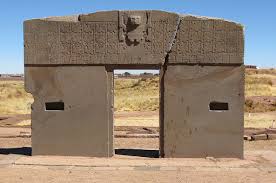The Mysterious Ruins of the Tiwanaku Empire Civilization

Found on the high plateau of the Altiplano, in Bolivia, the ruins of an ancient Inca village, Tiwanaku, which captured the attention of researchers at the beginning of the 20th century. With its complex engravings and inscriptions, the Gate of the Sun raises many questions. Located just a few hundred meters from the ruins, another place, just as enigmatic, has long escaped the attention of scientists.
The Gate of the Sun, the Temple of Kalasasaya and the field of ruins
At the start of the 20th century, a German engineer, Arthur Posnansky (1873-1946), studied the ruins of Tiwanaku for many years. From certain sections of walls which remained intact, he deduced the extent of the village and its buildings. His attention was focused mainly on the residential area, called in Aymara, the language of the Indians, Kalasasaya, which means “standing stones”. By studying the arrangement of the stones and their orientation, he concludes that it must have been a pyramid or an astronomical observatory, thousands of years old - which the German architect Edmund Kiss later confirmed.
Relying on the height of the building and its supposed orientation, the latter tries to date it and concludes that it had been built around 15,000 BC. The estimate was greeted with great skepticism in scientific circles, and new groups of researchers continued to collect data until the 1920s.
Some confirmed the first date, but others, including Posnansky, took into account new factors. According to the latest published estimates, the building was built between 10,150 and 4,050 BC. In 1981, the analysis of a sample made it possible to advance the date of 1580 BC, but it was specified that the sample was probably not representative of all the building and undoubtedly came from a wave of relatively recent work.
It was at this time that archaeologists finally included in their research the ruins of Puma Punku, which are located a few hundred meters from the village of Tiwanaku.
A building game
The field of ruins includes blocks of stone weighing up to 100 tonnes, apparently from several buildings. Unusually shaped, these blocks, worked with precision, can be arranged in several ways, by superposition or by juxtaposition, a bit like a building game. The stones were assembled by a system of metal staples, a process that archaeologists had already been able to observe at Delphi, however distant several thousand kilometers.
No one knows today how Puma Punku and Tiwanaku were destroyed. A comparison of the techniques used in stonework shows that the two sites do not date from the same era. The distance between them being very small, exchanges in the techniques used would have been logical, if not, inevitable. What is more, the destruction of Puma Punku was much more radical - the structure of the buildings is barely visible and there is hardly any stone left standing - while there are still some isolated sections of wall in Tiwanaku. If an earthquake had caused the destruction of Puma Punku, which is quite likely given the location of the site, the damage would have been just as great in Tiwanaku. This not being the case, it must be concluded that Puma Punku is much older than Tiwanaku. But this circumstance raises a new question. The Indians of this region knew neither writing nor metal: it is therefore impossible to attribute to them the system of metal staples. We can also doubt that they knew how to work the stone with as much precision. Furthermore, the populations living on the Altiplano also do not attribute the authorship of these sites to their ancestors. According to their legends, they are the work of gods or giants who came to settle there. If this is ever proven, it would still be necessary to explain where they came from and where they are now!
The Gate of the Sun

The Gate of the Sun of Tiwanaku, unlike the “building toy” system observed at Puma Punku, is made of a single block and weighs more than 10 tonnes. It is decorated with bas-reliefs and engravings, mainly located above the opening of the door, 1.40 meters from the ground.
The central bas-relief represents a figure armed with two javelins or scepters in the shape of a snake and surrounded by forty-eight assistants, among which thirty-two have a human face and sixteen a condor's head. It is generally accepted that the central figure represents the god of Creation: Viracocha.
In spring, the sun is placed exactly in the vertical axis of the center of the door. The forty-eight figures carved in stone perhaps represent a calendar, which would constitute a new reference to astronomy.









































































































































































































































































































































